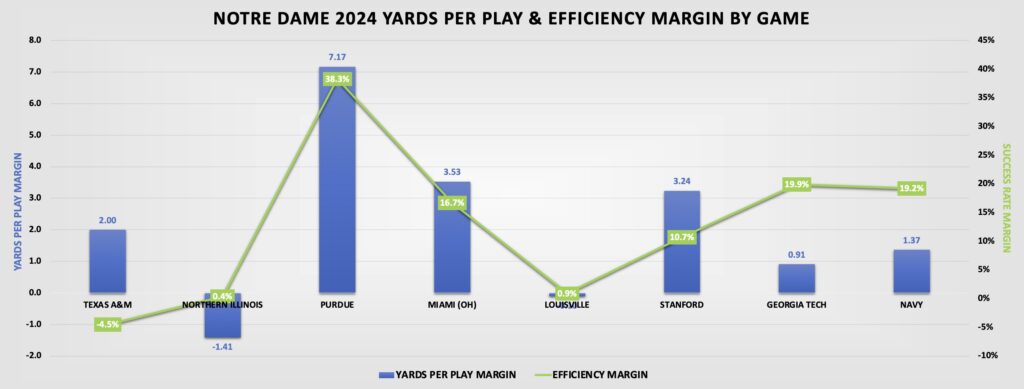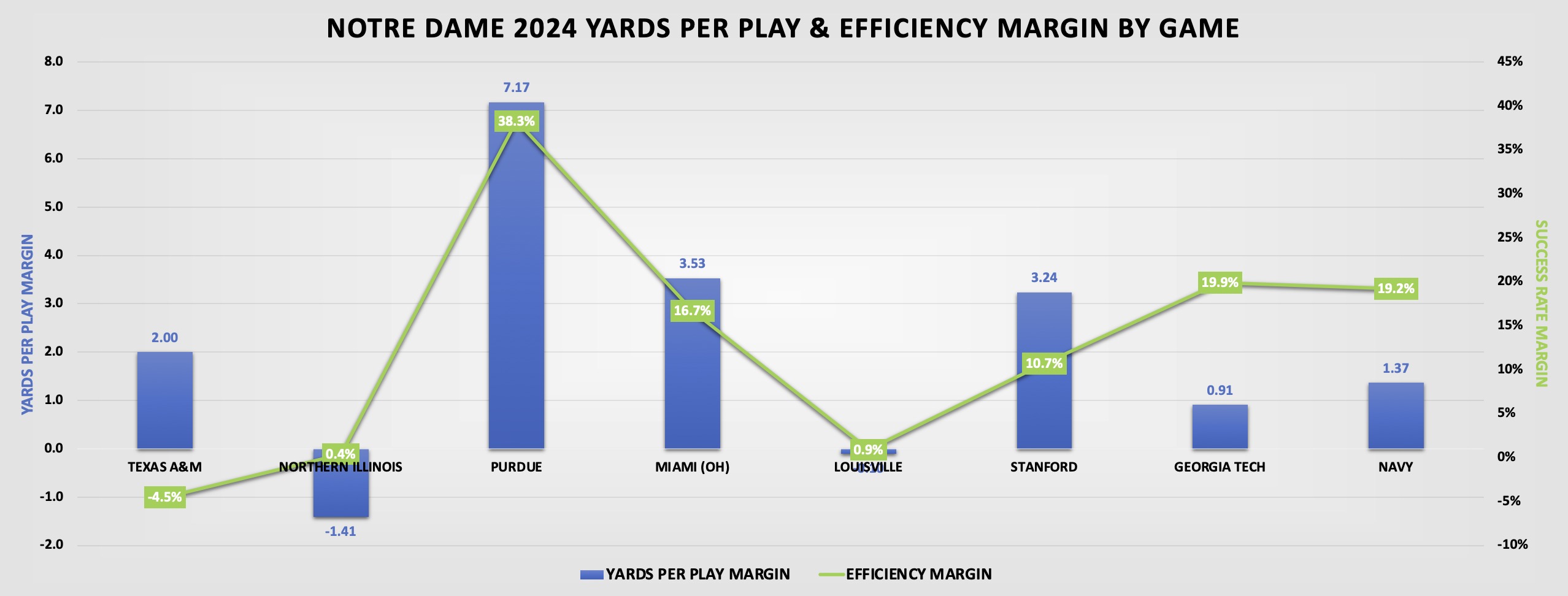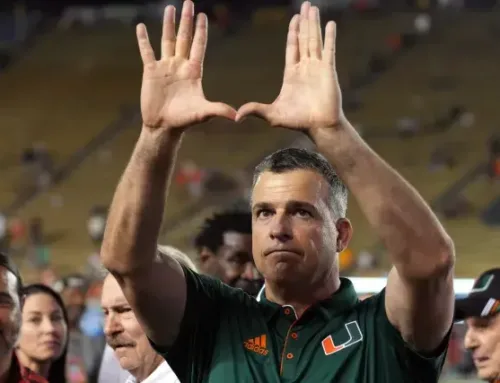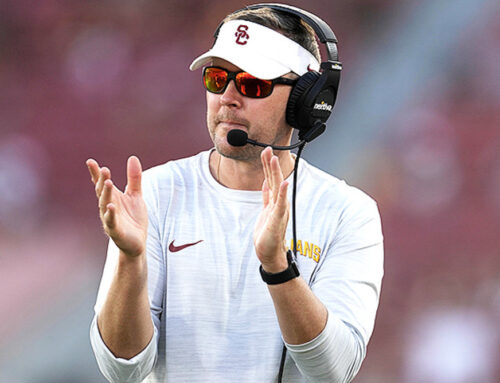With advanced stats recaps on vacation the last few weeks, we have some catching up to do! With the calendar turning toward November and the playoff picture beginning to take shape, let’s check on in Notre Dame’s season-long advanced stats and what strengths and weaknesses could fuel or doom a 12-team playoff run.
Offensive Profile

There’s been no shortage of frustration with the early-season offense. Riley Leonard struggled to get the passing offense humming with efficiency, the rebuilding offensive line lost multiple starters, and the receivers remain hit-and-miss. But for all the fretting, Mike Denbrock’s unit is performing. The Irish check in at 14th in Offensive F+ and offensive points per drive, 16th in EPA (expected points added) per play, and 14th in points per drive.
The backbone of this improving offense is the Irish rushing attack, which has simply been elite (#2 in EPA/rush). It seemed impossible that after losing two NFL caliber tackles and Audric Estime that the rushing game could improve, but Leonard’s legs have simply been game-changing. As you can see above, the run explosiveness is through the roof – both breaking these long gains frequently and also hitting longer home runs. The efficiency for running backs has taken a small hit versus Estime’s 2023 numbers, but that’s been largely offset by Leonard’s consistent rushing success.

Passing has been perceived as the glaring Achilles heel for this unit, but with one glaring exception it’s been competent enough (and is improving). The current formula – 55th in passing success rate with extremely low explosiveness – is a problem. But it feels like there’s reasonable upside in both areas. Leonard’s efficiency is improving week over week after the rocky start, and if dangerous receivers can get healthier (Mitchell Evans, Jordan Faison) or continue improving their chemistry (Beaux Collins, Jaden Greathouse, Kris Mitchell) the passing explosiveness could see a bump.

It’s not the most efficient overall, but this Irish team excels in key areas that are incredibly valuable when you pair them with a strong defense. They’ve been excellent converting scoring chances (4.53 points per quality drive, 9th nationally), don’t put the ball in danger or allow many sacks, and are very strong converting on 3rd/4th down and short. The defense (much more than special teams) has gifted them the 7th best average starting field position and the offense has taken advantage.
Individual Rushing Breakdown

It’s been an outstanding first eight games for Notre Dame’s top three ballcarriers, with each well over six yards per carry for 2024. For context, last year’s Audric Estime numbers: 6.39 YPC, 54.9% success rate, 13.7% explosive run rate, and 4.27 yards after contact. Let’s dive a little bit deeper into each:
- Jeremiyah Love: It’s a little bit shocking to see Love with the lowest explosive run rate of the group. But that’s indicative of the high bar this group is setting and understated because Love’s explosive runs are trending toward home runs and triples as opposed to 12-20 yards gains.Love ranks 2nd in PFF’s elusiveness score among all running backs, trailing only Ashton Jeanty. This metric basically isolates what rushers do once someone tries to tackle them, focusing on missed tackles forced and yards after contact (where Love is a top-20 back nationally in both metrics). The efficiency is solid, not great, but the sophomore is avoiding negative plays and doing ridiculous things in the open field.The power run numbers are such small samples (8 attempts for Love) that they should be taken with a grain of salt. But it’s worth monitoring as the short-yardage back role feels very open for the occasions where Riley Leonard hands it off.
- Riley Leonard: Having an elite running QB is a virtual cheat code for modern offenses, and Leonard’s effectiveness on the ground has translated from Durham to South Bend. He combines outstanding efficiency and strong explosiveness and virtually always gains positive yardage. After a two-year break from QB sneaks with Drew Pyne and Sam Hartman, Leonard has been incredible in power run situations – his only failed attempt coming in College Station on a play replay probably should have overturned.Looking at Leonard’s historical rushing numbers, he’s actually more of a candidate for positive regression (7.54 yards per carry in ’22/23 at Duke) than a drop-off. He’s scrambling notably less so far this season than at any other point in his career – before the Navy game, only 18% of his rushing yards coming from scrambles compared to far higher levels at Duke (54% in 2023, 43% in 2022). In a critical game, Mike Denbrock could be tempted to feed Leonard even more designed runs – I can imagine a playoff game against a top defense where QB rushes help the Irish stay on schedule, control possessions, and generate quality scoring chances.
- Jadarian Price: There’s been more “boom or bust” with Price, but he’s reeling off double-digit gains at a higher rate than Love and Leonard and nearly 5 yards after contact per carry is absurd. He only has one power run attempt this year (why?) but converted it. The stuffed runs are a slight concern, as even in 2023 with a strong offensive line he hovered around a 20% mark. But if he can turn some of those into small gains he should realize some efficiency and be right with Love in terms of yards per carry.
Run Game Physicality: Broken+Missed Tackles and Yards After Contact Per Attempt
(Added Missed Tackles out of curiosity) https://t.co/yk1mBXljlA pic.twitter.com/sbH1bnW6ae
— parker fleming (@statsowar) November 5, 2024
Individual Receiving Breakdown
It’s another weird season for Irish pass-catchers without a ton of volume and with a lot of week to week volatility in terms of target shares (especially beyond Beaux Collins). The lack of passing explosiveness has a significant trickle-down effect across all receiving stats, and the downfield passes are also far more limited than 2023. Riley Leonard’s average depth of target (7.7 yards) is far below Sam Hartman’s (10.2 aDOT) in addition to the early season struggles with efficiency. It’s important context for the receiving numbers below – these describe what happens when a player is targeted, but not the quality of the passes and how receivers are being deployed and targeted for better or worse.

- Beaux Collins emerging as WR1 isn’t a total surprise, but nearly doubling up the next receiving option in targets is pretty shocking. He’s been the most consistent and targeted downfield threat, and leads all receivers in yards per route run by a pretty healthy margin. Still, the efficiency is just ok and hasn’t flashed much YAC ability throughout his career. The drops have also been a pretty consistent issue going back to his Clemson days. The Irish WR room is fortunate to have him but he’s overcast as a WR1 on a playoff contender.
- Jaden Greathouse leads all receivers in yards per target and has been one of the most explosive options so far for Riley Leonard. But unlike Collins, his snap counts haven’t been very consistent as the wide receivers rotate and even in his higher usage games have peaked at around 50% of offensive plays. Even when on the field he hasn’t been targeted very often despite his productivity.
- Kris Mitchell’s numbers have to be considered a disappointment at this point. The needle seems to be pointing slightly up after initially being buried a bit in the WR rotation, but the lack of explosiveness (both long plays and yards after the catch) are rough considering his production at FIU. With Jordan Faison getting healthy and Jayden Thomas out-producing him, keep an eye on his role.
- Mitchell Evans is simply not being targeted downfield, leading to a massive drop-off from his 2023 numbers. The low volume as he recovers make sense, but the aDOT at 3.5 yards versus 10.2 a season ago feels like a miss for Mike Denbrock. The efficiency is strong when targeted, but so much work in the flat and lack of medium-deep targets seems like a waste unless there’s physical limitations we’re not aware of.
- Running backs typically look worse in these rankings relative to other receivers thanks to last resort passes and low depth of target, but Jeremiyah Love has been explosive despite starting his average reception behind the line of scrimmage. The efficiency isn’t there but I’d bet on Denbrock continuing to split Love out wide and hitting an explosive pass or two before the season ends.
- Jayden Thomas is another victim on inconsistent and low volumes of routes run. But in a small sample he’s getting targeted more often than other wide receivers when on the field. The productivity isn’t great so far, but he’s seen one of the lowest rates of catchable passes so far. The drops are concerning but haven’t been a historic issue so some positive regression should be incoming there.
- Jayden Harrison has settled into a niche role, especially with Faison back to playing significant snaps. His numbers are decent with a diet of touch passes that function like end-arounds and deep shots.
- Jordan Faison’s 2023 numbers were outstanding, but between the passing game struggles and injuries it’s been a slow season. The sophomore is the best bet to elevate the explosiveness of the passing game with his run after the catch ability on screens and potential to open things up downfield.
- Eli Raridon is in a similar boat to Mitchell Evans. He’s leaking out on RPOs to convert some easy yards but not seeing downfield targets.
Again, the general trend is up for efficiency and explosiveness. And if the rushing game remains as danger, it’s not going to take a world-class passing attack to score points. If Denbrock and Riley Leonard can push the explosiveness up from one of the worst in FBS to above average, the ceiling of this offense (and this team as a whole) goes up in a meaningful way.
Defensive Profile

Notre Dame’s defense has been elite and extremely well-rounded. The Irish rank top-5 in opponent EPA/rush (5th), EPA/pass (3rd), quality opponent possessions (1st), and opponent points per drive (5th). The radar graph above shows the winning formula for Al Golden – willing to bend a bit in the run game (42nd in opponent rushing success) and not creating tons of havoc, but excellent in preventing big plays and lethal on passing downs.

In the games where the Irish defense has surrendered yards and points, it’s often been from opponents finding more success on the ground. While the lack of explosiveness is terrific, there’s not a ton of disruption going on, which means teams can fairly reliably generate some 3rd and medium-short opportunities if they stick with early down runs. Northern Illinois ran this gameplan fairly well, averaging just 4.3 yards per carry but getting to an average 3rd down distance of just over 4 yards for a first down. Louisville and Navy each also notched over 6 yards per carry with more explosive runs and average efficiency, but were unable to convert their scoring chances between the Irish defense stiffening and turnovers.

Meanwhile, the passing defense has been fantastic as expected. There’s been a few rare busts – notably the fluky long TD from Northern Illinois – but long stretches of dominance. The pass rush has generated pressure but not consistent sacks, which works fine with the ball-hawking secondary (12th in passes defended per game). Notre Dame is tied for 6th nationally in turnovers forced with minimal luck involved. Sure, Navy fumbled a bunch of times without much help, but the Irish are still recovering less than 50% of opponent fumbles for the year and right at the expected rate for turning defended passes into interceptions.
The main question for the passing defense is sustainability with the injuries that have steadily stacked up. Without Jordan Botelho, Boubacar Traore, and Benjamin Morrison, there’s both a quality drop-off and extremely thin cushion when it comes to quality depth. That may not matter until the last few weeks of the season, but it’s worth monitoring as the schedule has also broken pretty favorable when it comes to opponent passing attacks. Outside of Louisville (15th in Offensive F+), the marquee opponents have all struggled to get their aerial attacks going, with Conner Weigman struggling then getting benched at A&M, the FSU offense completely falling apart, and getting Georgia Tech with Haynes King out.
With USC flailing and making a recent QB change, there may not be a team left on the schedule with a strong enough passing and rushing attack to take advantage of the weakened Irish defense. But there’s a good chance any playoff opponent will test the Irish defense – especially the young pass rush and new corners.
Big picture

Despite the gruesome NIU loss, Notre Dame has cemented itself as a clear top-10 team (#9 in F+, #6 FPI) that has largely handled its business against an easy schedule. In a year with no dominant team and many flawed teams jockeying for at-large playoff bids, the Irish are decently positioned, even if a first-round home game looks unlikely at this point. The first order of business remains taking care of business in the final four games, and then hoping the 12-team bracket breaks favorably with a 1st and potential 2nd round matchup avoiding the most talented teams in the B1G and SEC.





While the passing offense number for the whole season are… meh, I wonder how the metric changes week over week look?
My hypothesis is more or less a steady climb from abject disaster to something reasonable. Fingers crossed that sort of trend can maintain through the last 4 games.
Further, the rush defense stats only gives me concern for army. They seem much more content in the traditional service academy role of 15 play drives eating up 9 minutes. Never really got to see it from navy for turnover reasons, but also their paradigm shift to chase big plays.
I don’t know exactly what everything means here. But this site has ND F+ for each game. https://www.bcftoys.com/2024-ogr#notre-dame
It looks like the OGR stat is overall opponent adjust offense performance. This is the score by week. So trending up, but still fairly inconsistent.
0.17
(0.31)
0.76
0.15
0.02
0.87
0.29
0.92
The numbers are opponent adjusted, but seems like our aTm (0.17 – 23 pts against #14 D) and UL (0.02 – 28 pts against #27 D) performances were relatively much better than Miami (0.15 – 28 pts against #53 D) and GT (0.29 – 31 pts against #64 D). So who knows. Maybe garbage time makes a big difference here. Not sure if there is any concrete takeaway.
The trend line is definitely pointing up, but it’s a little bumpy as you adjust for opponent quality too
A&M: 5.3 YPA (yards/attempt), 30% pass success
NIU: 4.0 YPA, 37% success
Purdue: 7.0 YPA, 56% success
Miami OH: 5.7 YPA, 46% success
Louisville: 6.6 YPA, 35% success
Stanford: 7.9 YPA, 52% success
GT: 7.0 YPA, 55% success
Navy: 7.9 YPA, 41% success